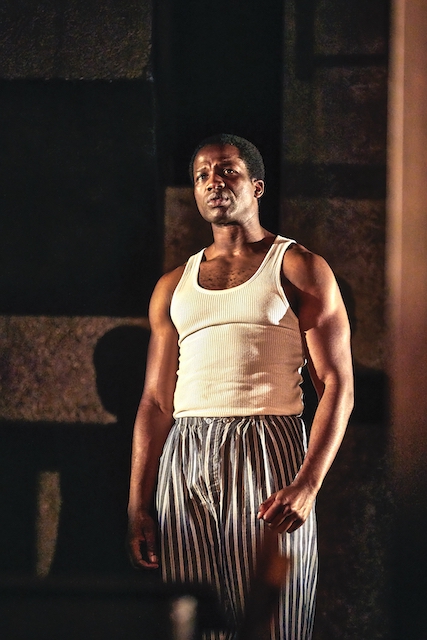It is 70 years since Willy Loman first paced a Broadway stage; 70 years since audiences were sucked into the vortex of a man trying to live America’s capitalist dream only to see his life crash and burn around him. This production, which transfers from the Young Vic, famously recasts Arthur Miller’s vision from a black man’s perspective, a powerful idea that gains heightened potency in an era in which Trump continues so shamelessly to reclaim America for the oppressed white man.
Director Marianne Elliott – who so brilliantly re-energised Sondheim’s Company last year by making the male protagonist a woman – collaborates with Miranda Cromwell to create a production that dynamically interweaves expressionism and naturalism. One of the reasons, of course, that it works so well to make Miller’s narrative racially charged is that his original inspiration for the white Willy Loman came from Brooklyn. Here the dynamic is subtly shifted from the start as members of the neighbourhood come together to sing the melancholic gospel hymn "When the Trumpet Sounds".
It's a letter from Truman’s America to Trump’s America
Characteristically for an Elliott production, every aspect of the design – both visual and aural – amplifies the emotional pull of the central performances. On Ann Fleischle’s clever minimalist set nothing entirely obeys gravity. Window and door frames are suspended on strings that enable them to be raised or lowered, similarly the Lomans’ kitchen table and chairs can sit comfortably on the ground one moment and ascend to the rafters the next. It’s an all too appropriate way of summing up the perspective of a man for whom the entire world seems to be flying out of control.
Wendell Pierce proves once more why his performance has been seen as one of the most exciting of the theatrical year. His Loman is a man trapped – by the lies society has told him about what he can achieve, and by the lies he has told himself. Pierce heartbreakingly embodies a man who is tortured by his contradictions. He is simultaneously filled with optimism and despair, pride and loathing, rumbles of macho strength and child-like weakness.
A particularly strong aspect of this endlessly galvanising production is Carolyn Downing’s sound design, which combines with Aidleen Malone’s lighting to add impact to Loman’s increasing inability to distinguish between past and present. The bubble of his delusions is enshrined most strongly in the expectations he imposes on his eldest son Biff. Here, when he remembers his sons’ childhood the scenes are replayed as if through a freeze-frame of snapshots. As the click and fizz of an old-fashioned camera resonates through the theatre, Pierce recoils, as if in pain: in this way, brilliantly, the distillation of memory through technology adds to the sense of how an idealised past is corrupting the wretched present.

The racial tension becomes most manifest in the upsetting scene where the exhausted Loman goes to beg his employer, Howard, to give him a desk job. In the best theatrical productions, there are moments where one tiny gesture can provoke an emotional earthquake. That comes when Matthew Seadon-Young’s Howard drops a cigarette lighter and Pierce is forced to stoop to pick it up. It would be a humiliation on any level: here a history in which such casual humiliations have all too easily escalated into violence makes it resonate still further. In that moment we see the beginning of the end.
Yet this is a production that also shows the play’s enduring power through its themes of over-charged parental expectations, the myths that families create for themselves, and the tragedy of watching anyone you care for slowly destroying themselves. It’s a brilliant reinvention, but it remains a story for anyone struggling to better themselves: it's a letter from Truman’s America to Trump’s America, one that shows how while everything changes at the same time nothing changes.
- Death of a Salesman at the Piccadilly Theatre to January 4, 2020
- More theatre reviews on theartsdesk














Add comment